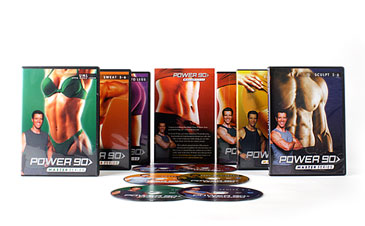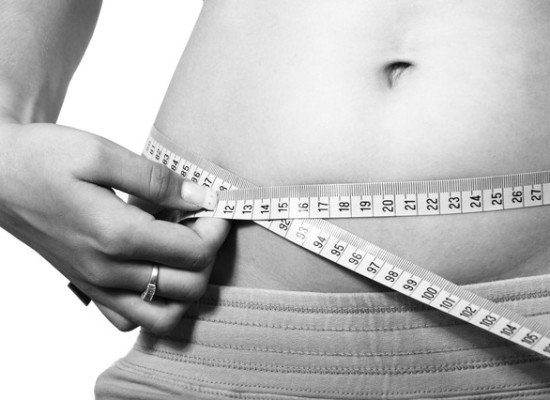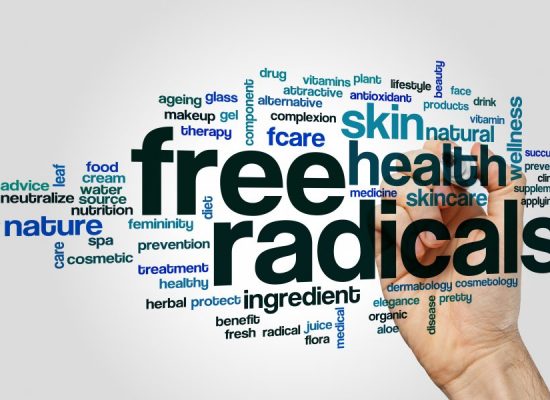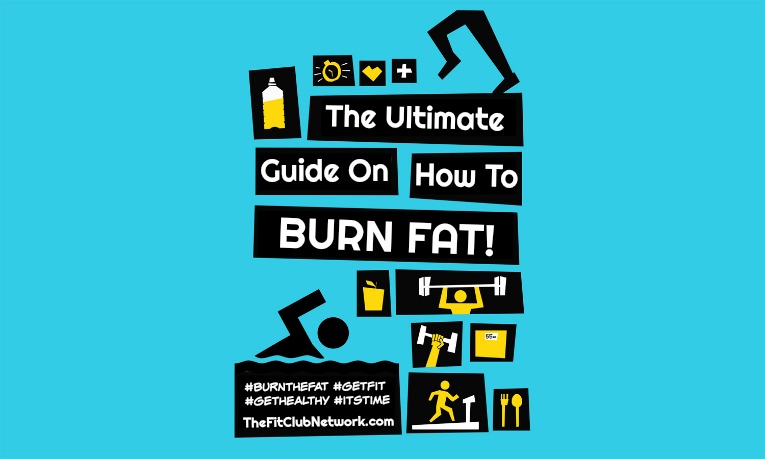

The Fit Club Network’s Ultimate Guide on How to Burn Fat
You might be surprised to hear that the body is designed to burn fat. Unfortunately, the eating habits and activity level of the majority of people have messed with their body’s settings so it’s no longer burning fat—it’s storing it. In our Ultimate Guide on How to Burn Fat, we’ll give you a clear understanding of how to burn fat so you can help reset your body to its original “factory” settings and start feeling better and looking healthier.
Before you can conquer anything, you need to learn about it. Here’s some helpful info to help you understand fat.
Understanding Fat
There is a common—and counterproductive—misconception that all fat is bad. People operating under this premise avoid foods like olive oil and avocados because these foods are high in fat content. This is really a mistake. We must understand the proper role of fats in our diet and further understand that certain types of fats are essential to proper body function and peak performance. So, I’m here to give you some helpful info on understanding fats.
Good Fats—Mono & Polyunsaturated Fats
Monounsaturated Fats (MUFAs) are helpful in a number of ways. MUFA’s generally:
- Increase good HDL cholesterol (yes, there is good cholesterol)
- Lower bad LDL cholesterol
- Fight plaque build up in arteries
MUFA’s can be found in olives, olive oil, canola oil, almonds, cashews, peanuts, peanut butter, sesame seeds and avocados. They should encompass the majority of fats consumed in a daily diet. Personally, I don’t place any limit on my MUFA intake. Most sources of MUFA’s are also high in calories, so be mindful of that. Nonetheless, there is considerable research indicating that MUFA’s actually assist in weight loss.
Polyunsaturated Fats (PUFAs) play a slightly different role and can:
- Lower bad LDL cholesterol
- Boost brain function + strengthen immune system (Omega-3)
- Assist in skin and eye health + function (Omega-6)
Cold water fish, such as wild salmon, mackerel and herring are great sources of Omega-3 fatty acids. Other sources include canola oil, flaxseed oil and walnuts. Omega-6 fatty acids can be derived from corn and safflower oil, corn-fed chicken and certain farmed fish. I don’t really like cold water fish, which is inevitably too “fishy” for me, so I take an Omega-3 supplement every day.
Bad Fats—Saturated Fats
Saturated fat is the fat you can visibly see on a piece of beef or chicken or that is in most dairy products and things like palm oil. These fats have very few benefits and have been proven to be a significant source of bad LDL cholesterol and contributor to heart disease. We need to significantly limit them in our diet.
One cup of 2% milk and one ounce of low fat mozzarella cheese have 3g of saturated fat, which is 15% of your recommended daily allowance. In my opinion, the RDA for saturated fats is far too high. Saturated fats should comprise no more than 10% of your daily intake.
Tony Horton is always pounding the drum of avoiding dairy products, such as cheese. One reason is that it contains much more saturated fats then your body needs or can actually process.
Really Bad Fats—Trans Fats
Have you ever heard the saying, “If it didn’t have a mother, or didn’t come from the ground, then don’t eat it.?”
This definitely applies to trans fats, which do not occur in nature. They are chemically produced from unsaturated fats. Why? Because they help extend the shelf life of pre-packaged foods…another miracle of modern science.
This gem can be found in shortening, margarine, doughnuts, french fries, crackers, chips, cakes, etc. If something sits on a shelf for any period of time, it’s probably got a fair amount of trans fats in it.
Like saturated fats, trans fats raise bad LDL cholesterol. But, it gets worse…they also lower good HDL cholesterol and increase inflammation in the body. Nothing like being bloated and destroying your heart.
Trans fats should be avoided. Not “limited,” but AVOIDED. They serve no positive purpose whatsoever, unless you’re looking for some heart disease and cancer.
Healthy Fat vs Bad Fat
A quick note on reading Nutrition Facts labels. Nutrition Facts are required only to show total fat, saturated fats and trans fats, so you have to be clever in reading them.
For example, one tablespoon of extra virgin olive oil has a whopping 14g of fat, but only 2g are saturated fats and the product contains 0g of trans fats. The label I’m reviewing actually lists the 11g of MUFAs and 1g of PUFAs that make up the remainder of the fats, but most labels don’t do this.
It’s unfortunate that the good fats and bad fats are all lumped together as “fat.” If good fats were called something different, then there would not be so much confusion in this area. Be sure to review those labels carefully, and don’t eliminate foods simply because they contain “fat.” Fats can help your body function properly and can help you achieve your fitness goals.
Here’s a little video for you with some more helpful info on healthy fat vs bad fat:
How Our Bodies Burn Fat
Knowledge is power, so the first step to losing weight is understanding exactly how to burn fat. So, let’s look at how our bodies work.
We get our energy from carbohydrates, protein and fat. The activity we’re doing determines which of these energy stores our body pulls from. My guess is that you may have already jumped to the conclusion that you want to use fat for energy so you’ll have less of it. Wouldn’t it be nice if it were that simple? Unfortunately, it’s not—using more fat does NOT automatically reduce fat.
In order to understand how to burn fat, we need to look at how our bodies get their energy.
The body’s main source of energy is fat and carbohydrates. It only uses a small amount of protein to repair the muscles after exercise. The exact ratio that your body will use depends on the specific activity.
High intensity exercises will burn more carbs, because our body can convert the carbs to fuel faster than it can with fat. Slower exercises burn more fat.
Now, here’s SUPER IMPORTANT information for you to understand—it does not matter which type of fuel our bodies use—what matters is how many calories we burn versus how many we consume.
The bottom line is that slower exercises are how to burn fat BUT just because we burn more fat does NOT mean we’re burning more calories.
We highly recommend you read this helpful post so you understand this concept extremely well—The Secret to Losing Weight. It wasn’t until Monica and I really started understanding this that we really started to experience weight loss and were able to keep it off.
 How to Burn Fat
How to Burn Fat
Alright, it’s time to dig in to all the proven effective ways to burn fat.
There’s a lot of info here—that’s why we called it the ULTIMATE Guide on How to Burn Fat 😊. Within each section below are a bunch of things you can do to help your body burn more fat. The best way to tackle it is to break it into parts—start with a section, choose which changes you’re going to adopt, then focus on each one until it starts to be habit.
If you’ve had an unhealthy lifestyle, I’d venture to say it’s been going on for awhile. Be patient as you learn how to burn fat and create new healthier habits that will last a lifetime.
CHANGE HOW YOU EAT TO BURN MORE FAT
In this first section of our Ultimate Guide on How to Burn Fat, we’re going to cover a bunch of ways you can change HOW you eat so that you body will burn more fat.
Again, tackle these one at a time until they start to become habit before moving on to the next one. Slow and steady wins the race!
1. Gradually reduce the amount of calories you consume. As we covered in detail in our post on The Secret to Losing Weight, the change that will have the most impact is consuming fewer calories. Note the word “gradually”—if you drastically cut calories, your body will go into defensive mode and preserve its fat stores in order to protect itself. That’s no bueno.
By reducing calories gradually, your body will adjust without hoarding fat. a reasonable daily calorie goal that you can reduce to gradually. You can calculate your ideal daily calorie total here—Recommended Daily Calorie Intake. (If you have any health concerns, it’s always best to seek advice from your doctor, nutritionist, or dietician for input on what will be best for your body.)
2. Turn your reduced daily calorie intake into a weekly or monthly average and alternate between low and high calorie days while maintaining your average. Our bodies are incredibly adaptive—it’s truly amazing. If you reduce your calories and your calorie intake is steady, your body may stop using your fat reserves. You may have heard the dreaded term “plateau”. Well, this is what’s behind it.
The key is to keep your body from knowing what’s going on by alternating between lower and higher and lower daily calorie intake so that it doesn’t know what to adapt to.
3. Always eat a hearty high protein breakfast. This may seem counterintuitive, but eating a big protein-packed breakfast every day actually boosts your metabolism.
In fact, people who skip it nearly 5x more likely to be obese. Oh, and things like sugar-filled coffee drinks, sugary cereal, donuts, etc., should never be a regular part of any eating plan to burn fat. Any carbs you have should be whole grain.
4. Eat small protein-packed meals every 2-4 hours. Another counterintuitive one. The key word is “small.” Eating boosts our metabolism. If we’re eating smaller meals more often, we’re helping to kick it into a higher gear throughout the day. Use your average calorie intake—or your portion control containers if you’re doing a program like the 21 Day Fix Meal Plan—as a guide for choosing what you eat at each meal. And, remember to keep your body guessing!
CHANGE WHAT YOU EAT TO BURN MORE FAT
Now let’s move onto changing WHAT you eat so you can help your body burn more fat.
1. Cut back on carbohydrates. The American diet is SUPER carb heavy, so many of us have developed some bad carb habits. Carbohydrates are our primary “outside” source of fuel and will usually be burned first by our bodies. By eating fewer carbs, we remove the “artificial” fuel source and allow our body to do what it was designed to do—burn its fat stores. (This is one of the cornerstone concepts of the Paleo diet, which we’ve always been fans of.)
Now, now all carbs are created equal—whole grains are MUCH better than refined sugar. Steel cut oatmeal is better than sugary cereal. Fruit is better than cookies.
Two final important points on this topic—1) It is NOT advised to cut out 100% of carbs, just to limit them and eat the good ones and 2) Just cutting carbs isn’t enough—you also need to reduce your total calorie intake as discussed above.
2. Eat more lean protein. Protein and carbs are typically pretty close in calories BUT our body doesn’t prefer using protein for fuel. Rather, our bodies use protein to build muscle and don’t turn it into fat. Again, balance is KEY as eating excessive protein can damage the liver and kidneys.
A little side note here—if you haven’t gotten the update yet, eggs are NOT bad for us. In fact, they’re one of the best lean proteins we can eat. Check out out post on eggs to get the good news—All ABout Eggs (The Real Truth)
3. Eat more fiber. Some studies have found that fiber can boost our body’s ability to burn fat by up to 30%, which would explain findings that people who eat the most fiber gain the least weight over time. Your goal is 25 grams of fiber a day (about three servings each of veggies and fruit).
4. Eat more healthy fat. You may think we’re crazy in a post about how to burn fat that we’re telling you to eat more fat. Key word = HEALTHY. A lot of people are still stuck in the bad intel we all got about fats decades ago. Newsflash—NOT ALL FATS ARE BAD (read this post to understand exactly why)! Healthy fats are found in nuts, avocados, olive oil, fatty fish, and low or nonfat dairy—so eat more of these.
5. STOP EATING SUGAR (and carbs are metabolized into sugar)! Sugar is evil. OK, that’s a bit dramatic, but it IS one of the biggest problems with the modern human diet—in fact, it’s an addition—and the primary reason behind America’s obesity epidemic.
Did you notice my mention of carbs? It’s VERY important to understand that our bodies metabolize carbohydrates into sugar—so in addition to our sugary coffee drinks, a can of soda (even diet soda!), or a candy bar being sugar, so is a bag of chips, a bowl of pasta or cereal, even an apple. The sugar in the former hits our blood sooner than the latter, but the end result is the same.
Watch this EXCELLENT short video to understand how sugar makes you fat:
I used to be a sugar burner. I had taught my body to store fat and burn sugar. Then, I started doing P90X and Insanity, followed by triathlons, and was burning a lot of calories. I lost weight—but, I kept pumping sugar into the machine because that’s what sugar burners do.
You have plenty of fat that’s already in your body. You don’t have very much sugar, so you have to keep throwing leaves on the fire to get it to burn. Doing that causes your blood sugar to rise, which causes your insulin to spike.
This has all sorts of side effects. The primary one I noticed was inflammation. I knew something had to change when my doctor informed me that if I kept taking 1,500 mg of Advil a day, I was going to need a kidney transplant. The secondary one was 40 extra pounds.
Rather than treating the symptoms with more medicine, I decided to address the core issue and that lead me to look at the effects of my high carb (high SUGAR) diet.
6. Eat spicy foods. Sounds hokey, but it’s actually been scientifically proven that capsaicin, which is what makes chili peppers spicy, can also boost our metabolism. As little as 1 tablespoon of chopped peppers per day can spike your metabolism by approximately 23%.
So add some spicy healthy salsa to your diet and make liberal use of those red pepper flakes (which are excellent on avocados by the way).
7. Drink green tea and coffee. Green tea and coffee are beneficial IF you don’t put a bunch of sugar in them. (Have you ever tried putting coconut oil in your coffee? I highly recommend it!) Some studies have found that they can boost our metabolism and green tea has beneficial antioxidant properties.
EXERCISE TO BURN FAT
We’ve been saying it for years—you can’t out exercise a bad diet! The concept that exercise burns fat isn’t earth shattering, but there are several things you can do to boost the burning.
1. Find little ways to be active throughout your day. Every little bit counts! Walk your kids to school or you to work instead of driving, ride your bike to the grocery store or post office, take the stairs instead of the elevator, clean your house or work in the garden more, park as far away from the store entrance as possible—the opportunities are countless and the impact adds up.
2. Do several shorter workouts instead of one long one. Similar to the concept of eating several small meals a day, it’s recommended to have several shorter workouts versus one longer one so you get multiple metabolism spikes versus just one.
3. Work out later in the day. Our bodies burn calories faster for several hours AFTER we work out, so late day workouts are better.
4. Do cardio AND strength training. Adding strength training to your workout will help you burn more fat. It will also replace any muscles you lose as a result of consuming less calories.
5. Do interval training. Interval training changes up your workout while you’re doing it. Basically, you workout at an “easy” pace for a bit, then give it your all resulting in high calorie burn and possible increased metabolism.
6. Do cross training. Cross training has the same impact as varying your daily calorie intake—it keeps your body guessing. It sounds intimidating, but all it means is that you vary up your exercise—one day you ride your bike, the next you workout at the gym or at home, and the next you swim or run.
We HIGHLY recommend Joel Freeman’s LIIFT4 Workout, which checks ALL of these boxes. This at home workout combines cardio and strength training and only has you working out four days a week.
Adopt New Healthy Behaviors to Help Burn Fat
Look to your lifestyle if you’re wondering how to burn fat. There are a lot of small changes we can make that will add up to big results.
1. Drink at least half your body weight in ounces of water every day. In addition to the MANY other benefits of drinking water, it actually may help us lose weight by causing a similar metabolic spike as eating. If you’re following the 2B Mindset nutrition plan, then you already know that “Water first!” helps you eat less at each meal. Try to consume your water throughout the day rather than in a short time period.
Some studies have found that drinking cold water raises your metabolism a bit, probably because your body has to exert some energy to bring the water down to body temperature.
2. Don’t drink (or severely restrict) alcohol. One of our most popular blog posts in our almost 10 year history is this one—Can I Drink Alcohol on the 21 Day Fix? This is a big deal for a lot of people. Unfortunately, alcohol is packed with carbs and/or sugar and moderation is tough, especially once you start. If you’re going the restriction route, a good rule of thumb is one drink if you’re a woman, two if you’re a man occcasionally.
3. Reduce your stress. Research has demonstrated that one of several common stress symptoms is the build-up of body fat. This is a result of stress’s effect on hormonal secretion and its physiological consequences.
Here’s what happens:
Cortisol sets off an increased rush of glucose from your tissues. It also starts the process of breaking down muscle tissue to make glucose…yikes! Remember, the body thinks something major is going down. In response to the rise in glucose comes the rise in insulin. You know the drill. Do this again and again, day after day, and what do you have? Eventually insulin resistance.
In the meantime, the cortisol is signaling the body to store fat. The body thinks it will need it, after all. Specifically, the body directs fat storage in the abdomen, around the organs, where there are more receptors for cortisol and a greater supply of blood. A lot of research has been done on this in the last few years highlighting the contribution of stress to abdominal fat in particular.
And, tell me…when you’re stressed, don’t you eat more? It’s a double edged sword, alright.
You’ve heard it before—meditate, do yoga, do self care, take a nap, be in nature, whatever works best for YOU. Our go to program when we’re feeling stressed out is the 3 Week Yoga Retreat.
4. Get enough sleep. You might think that being active would help you burn more fat, but bodies that are sleep deprived don’t burn carbs as efficiently as those who are well rested. This is because a lack of sleep impacts our hormone levels, which make our body hold tight to fat and crave sugars. The general rule of thumb is 7-9 hours a night.
5. Weigh yourself daily. This one comes with a big caveat as it’s a shift from our previous stance. IF you are NOT doing a strength training workout regime (which you should be if you’re following this Ultimate Guide on How to Burn Fat!) and you ARE following a solid nutrition plan, weighing yourself daily can be a helpful tactic.
We learned this from the 2B Mindset program. The rationale is that it tunes you into your body and helps you learn exactly what works and doesn’t work for your body. When you weigh yourself daily, you’ll start to see patterns in your weight losses/gains so you’ll have a much better understand of what to do OR not do more of. You can make changes much faster this way.
If you ARE doing strength training, be sure and understand #6 below really well if you’re going to be doing daily weigh ins.
6. Learn how to measure your progress right. Discouragement is a trigger for quitting. I see a lot of people want to give up when they don’t see the scale go down. NOTE: You can be losing fat but lose very little weight.
If you’re doing a muscle building workout like LIIFT4 or Shift Shop, you’re gaining muscle at the same time you’re losing fat—and muscle weighs more than fat. Here’s a visual:
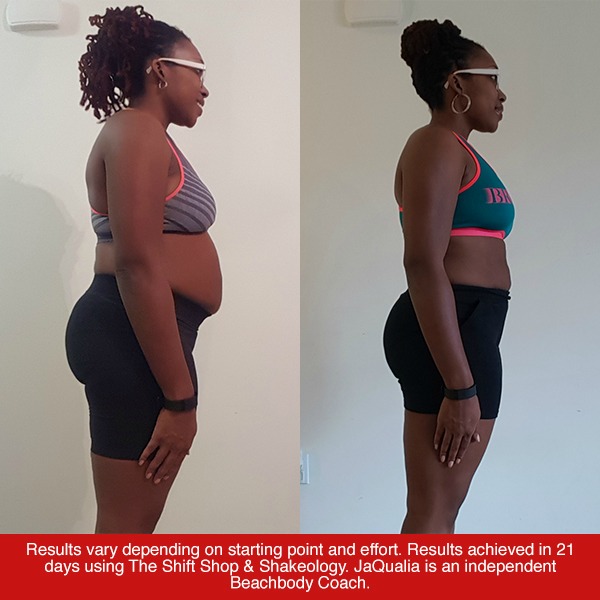
You wouldn’t know from looking at her drastic transformation that this woman lost only 9.8 pounds (doing Shift Shop and drinking Shakeology).
So you MUST factor this in as you measure your progress. Consider muscle gain, how you look and feel, your energy level, how you’re sleeping, etc.
7. Join a community of positive people who share your goal. It has actually been proven that surrounding yourself with positive people who share your outlook and goals boost your chances of success. This is behind our two health and fitness Facebook groups—The Insane Ward and Coach Monica’s Fix Family.
It’s a simple (and free) process to get in these groups. You can click on the links and request to join or contact us by clicking on the button below.
Another side note: If you’re bummed out by cellulite dimples on your body, definitely check out this post we did on how to get rid of them—How to Get Rid of Cellulite Dimples
We hope our Ultimate Guide on How to Burn Fat will help you get started on the path to weight loss AND stick with it.
Now that you understand how to burn fat, give it a shot. It worked for us. It has worked for thousands. Let us help you have it work for YOU.

